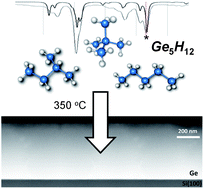We present an exploratory study to extend Ge-hydride chemistry and materials science beyond the classic GeH4 case to higher order analogs. We emphasize the Ge4H10 and Ge5H12 compounds for possible applications as chemical sources for the next generation Ge-based semiconductor technologies. Quantum chemistry simulations, based on the hybrid B3LYP DFT functional, are used to predict fundamental structural, vibrational and thermochemical properties of Ge5H12 conformers and isomers for the first time. Structural results for seven distinct isomers including neo-Ge5H12, two branched conformers (i1-Ge5H12 and i2-Ge5H12) and four chained isomers derived from the linear chain n-Ge5H12 are presented, and reveal geometry and bonding motifs very similar to those found in tetragermane. This structural analogy is then used to interpret the vibrational spectrum of Ge5H12 in relation to Ge4H10 and identify key distinguishing features. Hindered-rotor corrected free-energies of the prototypical neo (tetrahedral) and n (linear) Ge5H12 isomers are predicted to be +3.4 kJ mol−1 and +2.8 kJ mol−1 above that of the branched ground state structure. This thermochemistry data is then combined with corresponding results for the GenH2n+2 (n = 1–4) compounds to study their sequential reactions via germylene insertion, which convert an nth-order molecule to its (n + 1)th relative, culminating in Ge5H12. The equilibrium for these reactions is then solved for a range of temperature and initial reactant concentrations and indicates that germane is the dominant species, followed by Ge4H10 and Ge5H12 in various ratios, depending on conditions. Our simulations may provide useful guidance for optimizing the production of Ge3H8, Ge4H10 and Ge5H12 as main products. The simulations are corroborated by initial experimental studies which also provide spectroscopic evidence for the formation of Ge5H12. The latter was subsequently used to undertake the first proof-of-principle depositions of high quality Ge structures on Si(100) indicating that this compound may represent both a viable and unique CVD precursor for ultra low-temperature and low-pressure fabrication.

You have access to this article
 Please wait while we load your content...
Something went wrong. Try again?
Please wait while we load your content...
Something went wrong. Try again?


 Please wait while we load your content...
Please wait while we load your content...